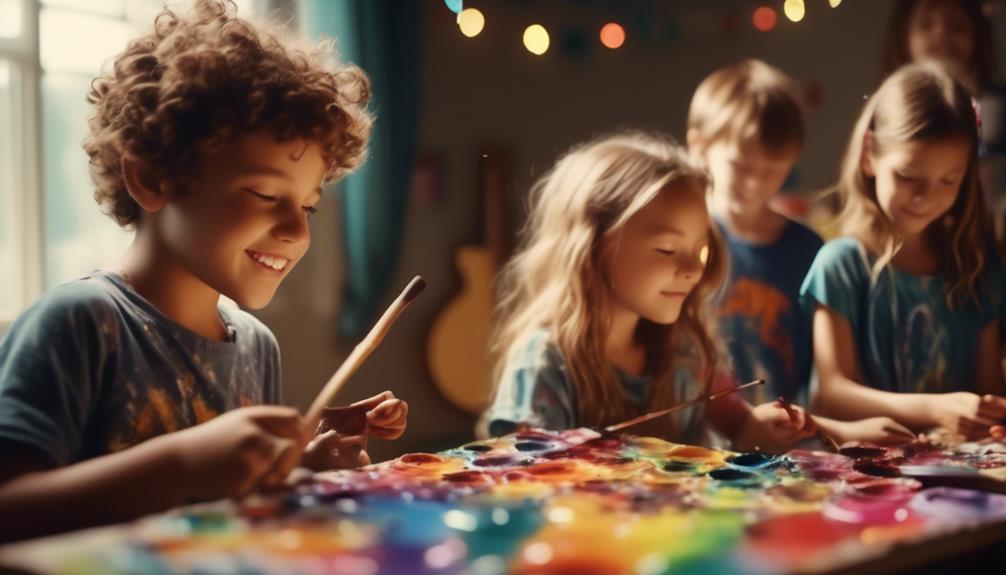Do Creative Activities Enhance Kids' Emotional Well-being

Engaging in creative activities can enhance kids' emotional well-being. By allowing them to express themselves and tap into their imagination, it can lead to a sense of joy, fulfillment, and self-confidence.
Creativity provides an outlet for children to freely express their thoughts, feelings, and experiences. It allows them to communicate in a non-verbal way that may be difficult for them to express through words alone. This can be particularly beneficial for children who struggle with verbal communication or have difficulty expressing their emotions.
In addition, engaging in creative activities stimulates the imagination. It encourages children to think outside the box, problem-solve, and explore new ideas. This process of imagination and exploration can be incredibly empowering for children, as it allows them to see the world from different perspectives and discover their own unique abilities and talents.
Furthermore, creative activities can bring a sense of joy and fulfillment to children. Whether it's painting, writing, dancing, or playing a musical instrument, engaging in activities that they enjoy and are passionate about can bring a sense of happiness and satisfaction. This sense of joy and fulfillment can have a positive impact on their overall well-being and contribute to a healthy emotional state.
Finally, participating in creative activities can boost children's self-confidence. As they develop their skills and see the progress they make, they become more confident in their abilities. This newfound confidence can extend beyond their creative pursuits and positively impact other areas of their lives, such as academics, social interactions, and problem-solving skills.
In conclusion, engaging in creative activities can have a profound impact on kids' emotional well-being. It provides an outlet for self-expression, stimulates the imagination, brings joy and fulfillment, and boosts self-confidence. Encouraging and fostering creativity in children is therefore essential for their overall emotional development and well-being.
The Emotional Benefits of Creative Activities
Engaging in creative activities has numerous emotional benefits for children. It helps them express their feelings, develop problem-solving skills, and enhance their overall emotional well-being.
Creative expression, such as through playwriting and short story writing, can foster mental growth and provide a sense of achievement. By creating their own stories, children can find their unique voice and gain self-confidence. This positively impacts their emotional well-being.
Poetry and journaling are also powerful tools for emotional development. They allow children to reflect on their emotions, develop empathy, and process their experiences. Through exploring their thoughts and feelings in writing, children can enhance their emotional intelligence and become more self-aware.
Additionally, letter writing can contribute to emotional intelligence and strengthen relationships. By logically processing their feelings and expressing them in a thoughtful manner, children can improve their communication skills and develop deeper connections with others. This not only benefits their emotional well-being but also promotes social development.
Furthermore, writing a gratitude list can have a profound impact on children's emotional well-being. By practicing mindfulness and actively seeking out things to be grateful for, children can change their perspectives and cultivate resilience. This simple activity can lift their mood and foster a positive mindset.
Enhancing Self-Expression Through Creativity
By providing children with a wide range of creative materials and experiences, their self-expression can be enhanced, allowing them to effectively express and cope with their feelings. Creative activities provide opportunities for children to explore their emotions and communicate them in unique and imaginative ways. When children engage in creative play, such as painting, drawing, or sculpting, they can express complex emotions that may be difficult to put into words. By using their creativity, children can externalize their feelings, gaining a sense of control and understanding over their emotions.
Creative experiences also encourage children to plan, design, construct, experiment, and revise their project ideas. This process allows them to explore different ways to express themselves, fostering their self-expression and creativity. Personal experiences with various people and situations further enrich children's creative expression, as they draw inspiration from the world around them.
In addition to hands-on activities, writing can serve as a powerful tool for self-expression. Journaling, short story writing, playwriting, poetry, and letter writing all provide creative outlets for emotional reflection. Through writing, children can delve deeper into their emotions, gaining clarity and perspective. They can express their thoughts and feelings in a private and personal way, promoting emotional well-being.
Boosting Confidence and Self-Esteem With Creative Pursuits
Creative pursuits have been shown to significantly boost children's confidence and self-esteem, contributing to their overall emotional well-being. Here are three ways in which engaging in creative activities can help boost your child's confidence and self-esteem:
- Journaling and creative writing: Encouraging your child to express themselves through journaling or creative writing activities can have a positive impact on their emotional well-being. These activities promote mindfulness and self-expression, allowing your child to explore their thoughts and emotions. By putting their thoughts into words, they can gain a better understanding of themselves and their experiences, leading to increased confidence and self-esteem.
- Short story writing: Engaging in short story writing provides an opportunity for your child to unleash their creativity. As they develop their storytelling skills, they'll experience a sense of accomplishment and pride in their work. This achievement boosts their confidence and self-esteem, as they see the results of their efforts and realize their creative potential.
- Playwriting: Encouraging your child to write and perform plays can have a profound impact on their confidence and self-esteem. Through playwriting, they can find their unique voice and improve their communication skills. The act of performing in front of others can help them overcome stage fright and develop a sense of self-assurance. This newfound confidence extends beyond the stage, positively impacting their emotional well-being in various aspects of life.
Developing Emotional Resilience Through Artistic Expression
Artistic expression is a powerful tool for developing emotional resilience in children. Through creative outlets, such as painting, drawing, or writing, children can process and express negative emotions in a safe and constructive manner.
Engaging in these activities fosters mental growth, problem-solving skills, and a sense of self-worth, ultimately enhancing their emotional well-being.
Art and Emotional Strength
Engaging in artistic expression allows children to develop emotional resilience and strengthen their emotional well-being. Through creative activities, children can enhance their mental skills, social development, and overall child development.
Here are three ways in which art can contribute to emotional strength:
- Processing Emotions: Artistic expression provides a safe and non-judgmental space for children to process and cope with their emotions. By engaging in creative experiences, children can explore their feelings and express them in a tangible form, facilitating emotional growth and self-awareness.
- Problem-Solving Opportunities: Creative activities foster mental growth by encouraging problem-solving and critical thinking. When children engage in art, they're presented with challenges and opportunities to find innovative solutions, which helps them build resilience and adaptability in the face of obstacles.
- Unique Perspectives: Artistic expression acknowledges and celebrates children's unique perspectives. By valuing their creative ideas and encouraging their imagination, art promotes emotional well-being and self-esteem. It allows children to feel seen and heard, fostering their sense of belonging and enhancing their emotional resilience.
Creative Outlets for Resilience
Developing emotional resilience through artistic expression provides children with valuable tools to navigate challenges and foster their overall well-being. Creative activities serve as effective outlets for children to express and cope with their emotions, promoting emotional well-being. By providing a wide range of creative materials and experiences, children are given the opportunity to explore and pursue their ideas, enhancing their creativity and emotional health. Additionally, engaging in playwriting allows children to develop their unique writing voice, increasing self-confidence and positively impacting emotional well-being. Poetry, on the other hand, helps children reflect on their emotions, learn empathy, and enhance emotional intelligence and well-being. Writing letters also plays a crucial role in strengthening relationships, improving overall mental health as children organize their thoughts and process their emotions. Through these creative outlets, children develop resilience and acquire important skills to face and overcome life's challenges.
| Creative Activity | Benefits |
|---|---|
| Playwriting | Develops unique voice, increases self-confidence, impacts emotional well-being |
| Poetry | Reflecting on emotions, learning empathy, enhancing emotional intelligence and well-being |
| Writing letters | Organizing thoughts, processing emotions, strengthening relationships, improving mental health |
Fostering Social Connections and Emotional Well-Being Through Creative Collaboration
Collaborative play is a powerful tool for fostering positive social connections and promoting emotional well-being in children. When children engage in creative collaboration, they have the opportunity to develop and enhance their social skills, social interactions, cooperative behavior, and communication skills.
Here are three ways in which collaborative play can contribute to children's social and emotional development:
- Stimulating Communication: Collaborative play, especially in the form of cooperative games, encourages children to communicate effectively with their peers. They learn to express their thoughts, listen to others' ideas, and work together towards a common goal. Through this process, children develop their communication skills, which are essential for building strong relationships and resolving conflicts.
- Building Trust: Engaging in collaborative play requires trust and reliance on others. Children learn to trust their peers as they work together, share ideas, and rely on each other's contributions. This fosters a sense of teamwork and cooperation, laying the foundation for positive group dynamics and supportive relationships.
- Promoting Positive Social Behaviors: Collaborative-creative play programs have been found to have positive effects on social and emotional development. Through these activities, children learn to take turns, share resources, and respect others' ideas and perspectives. They develop empathy, compassion, and a sense of fairness, which are crucial for positive social interactions.
Using Creative Activities as a Stress Relief and Emotional Outlet
Using creative activities as a stress relief and emotional outlet can provide children with a constructive way to express and cope with negative feelings. Engaging in creative activities, such as play, writing, and art, allows children to find emotional satisfaction and release. These activities provide a safe and non-judgmental space for children to explore their emotions and process them in a healthy manner.
Journaling and writing creatively, for example, promote mindfulness, self-awareness, and emotional reflection. By putting their thoughts and feelings onto paper, children can gain a deeper understanding of themselves and their emotions. This form of self-expression can be a powerful tool for managing stress and finding solace during challenging times.
Similarly, engaging in creative play and activities allows children to channel their emotions into something productive. Through play, children can create imaginary worlds, act out scenarios, and experiment with alternative solutions. This not only fosters mental growth and problem-solving skills but also provides a much-needed emotional outlet.
Cultivating Emotional Intelligence Through Creative Engagement
Cultivating emotional intelligence through creative engagement has numerous benefits for children.
Art therapy provides a platform for emotional expression, allowing children to communicate and cope with their feelings effectively.
Art Therapy Benefits
Art therapy has been proven to enhance children's emotional intelligence and promote their overall well-being through engaging in creative activities. Here are three benefits of art therapy for children's mental development:
- Emotional expression: Art therapy provides a safe and non-verbal outlet for children to express their emotions. Through drawing, painting, or sculpting, they can communicate their inner thoughts and feelings that may be difficult to express verbally. This process helps children understand and manage their emotions more effectively.
- Problem-solving skills: Engaging in art therapy allows children to experiment with different materials and techniques, encouraging them to think creatively and find alternative solutions. This fosters their problem-solving skills and helps them develop a flexible mindset when facing challenges.
- Self-awareness and self-esteem: Art therapy boosts children's self-awareness by encouraging them to explore their identities, strengths, and weaknesses. It also provides a sense of accomplishment and validation, enhancing their self-esteem and confidence.
Incorporating art therapy into children's lives can have profound positive effects on their emotional well-being and overall development.
Emotional Expression Through Creativity
Engaging in creative activities not only enhances children's emotional well-being but also cultivates their emotional intelligence by fostering emotional expression through creativity. Creative experiences provide children with a safe outlet to express and cope with their feelings. Whether it's through art, writing, or other forms of creative expression, children can explore and communicate their emotions in a unique and personal way.
By engaging in creative play, children have the opportunity to experiment with new ideas and problem-solving, which promotes mental growth and emotional development. Poetry, for example, allows children to reflect on their emotions and find a sense of release. Writing letters helps them organize their thoughts, experiences, and emotions.
Through these creative activities, children gain a deeper understanding and awareness of their own emotional well-being, fostering emotional intelligence and resilience.
Frequently Asked Questions
How Does Creative Activities Support Emotional Development of a Child?
Engaging in creative activities like art therapy, role playing, music therapy, and dance therapy supports your emotional development. These activities help you express and regulate your emotions, build self-esteem, and develop problem-solving skills, fostering your overall well-being.
What Are the Benefits of Creative Activities for Children?
Engaging in creative activities benefits children by fostering self-expression, enhancing emotional regulation, and promoting learning through creativity. Art therapy and creative outlets play a vital role in developing their emotional well-being.
What Does Creative Play Help a Child's Development?
Creative play is like a colorful canvas for a child's development. It nurtures imagination, problem-solving skills, self-expression, and cognitive growth. Through creative activities, kids can explore emotions, think creatively, and enhance their overall well-being.
How Can I Help My Child With Emotional Wellbeing?
To help your child with emotional well-being, get involved as a parent. Build emotional intelligence by encouraging self-expression and promoting mindfulness. Creative activities, like writing and art, can be powerful tools in fostering their emotional growth.










